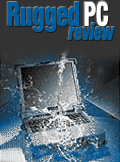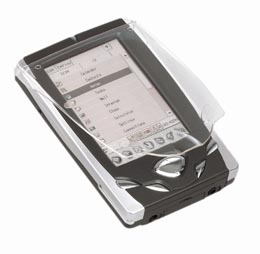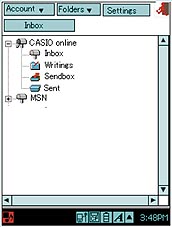

|
|
|
|
|
|
Casio Pocket Manager BE-300Pocket PC or not Pocket PC? (July 2001 issue)
Apparently, Casio has concluded that it is not
possible to offer a full-featured color Pocket PC at a price low enough to appeal
to the public. Microsoft has been stressing that licensing Windows CE and its
applications is now easier and less expensive. We are not privy to the licensing
cost structures, but apparently they are still high enough for Casio to take a
different approach. Enter the Cassiopeia BE-300. It is still a Windows CE
device, using the embedded version of the OS, but it is not an "official" Pocket
PC. You won't find any of the Pocket apps on it and it won't run Pocket PC
software (though Casio says such software can easily be ported). The BE-300 is
targeted at business professionals and students who value simplicity and
versatility but still want all the color and multimedia power of a Pocket PC.
The BE-300 has a distinct look of its own, though it borrows both from Casio's
Pocket PCs and its line of low-cost Pocket Viewers. Like the Pocket Viewers and
most Palms, the BE-300 has a protective screen lid similar to that of the Jornada
Pocket PCs. Like the E-100 series, the new model sports a Type II CF-Card slot
instead of the MMC slot of the EM-500. All controls are on the front of the
device: a directional cursor disc, power, menu, ok, and escape buttons. Never
having been a fan of Casio's confusing array of controls along the left side of
their Pocket PCs, I like that arrangement.
The BE-300's screen is both good
news and not so good news. The good news is that it supports 32,000 colors. The
not so good news is that it's a STN display and not one of Casio's trademark
superbright TFTs. Onboard memory is just 16MB, the same as on the EM-500, but
there is also 16MB of Flash ROM. Much better news comes from the engine
department where you find lurking a 166MHz version of NEC's fabulous new VR4131
processor. We're talking 280MIPS here, and likely at least a match for the 206MHz
StrongARM. With a footprint of 4.75 x 3.0 inches and a thickness of 0.625 inches,
the BE-300 is a bit smaller and thinner than the EM-500 and quite a bit handier
than the big E-100 Series. The battery is a rechargeable Li-Ion pack (good for
"one week of use"), and PC connectivity via a USB/serial connector.
Casio
stresses the BE-300's wireless communication potential via wireless CF Card
modems such as the enfora (formerly Nextcell) Pocket Spider or wireless PC Card
radios that the BE-300 can accommodate via an iPAQ-style PC Card sleeve. All will
take advantage of Casio's myCasio.com mobile portal. The BE-300's cradle,
included, looks pretty much the same as that of the Casio Pocket PCs but is in
fact a new design. There will also be other options such as an external modem, a
foldable keyboard, and a snap-on battery pack as is available for the EG-Series.
At this point it is hard to peg the BE-300. Listing at $299, it
offers good value and is not meant to replace Casio's high-end Pocket PCs. In the
same respect, a Windows CE-based PDA without Microsoft's software may further
confuse users and also further dilute whatever brand awareness Pocket PC has
managed to establish. If the BE-300 is Casio's protest against Microsoft's
licensing strategy, then this would not bode well for the Pocket PC platform.
|
 According to a study by PC Data, PDAs with retail prices of under US$400
commanded 93.7% of the market between March and December of last year, and almost
2/3 of all PDAs fell into the US$200 to US$399 category. The results may be
different this year due to price reductions especially in the Palm OS camp, but
the clear conclusion is that devices costing over US400 only have a very small
slice of the market. And that is where almost all Pocket PCs are. HP realized
that when it introduced the Jornada 525 at $299. The Jornada delivers almost all
the power and multimedia features of a top-of-the-line Pocket PC at a much more
popular price point. Casio apparently was equally frustrated. After having been a
pioneer in all sorts of PDAs--organizers, handhelds, and palmtops--Casio has seen
its marketshare erode despite having introduced the first real multimedia PDA in
the Cassiopeia E-100-Series and despite the terrific, but greatly
underappreciated, EM-500.
According to a study by PC Data, PDAs with retail prices of under US$400
commanded 93.7% of the market between March and December of last year, and almost
2/3 of all PDAs fell into the US$200 to US$399 category. The results may be
different this year due to price reductions especially in the Palm OS camp, but
the clear conclusion is that devices costing over US400 only have a very small
slice of the market. And that is where almost all Pocket PCs are. HP realized
that when it introduced the Jornada 525 at $299. The Jornada delivers almost all
the power and multimedia features of a top-of-the-line Pocket PC at a much more
popular price point. Casio apparently was equally frustrated. After having been a
pioneer in all sorts of PDAs--organizers, handhelds, and palmtops--Casio has seen
its marketshare erode despite having introduced the first real multimedia PDA in
the Cassiopeia E-100-Series and despite the terrific, but greatly
underappreciated, EM-500.
 The BE-300's software apps are totally different from the standard Pocket PC
applications. Standard in ROM are the top menu, calendar, contacts, to do, memo,
email, web browser, data sync, calculator, clock, backup, and setup. From the
accompanying CD you can load an MP3 player, a movie viewer, a file manager, and a
camera application. A software development kit is available at no charge. The PIM
software looks clean and logical and in many ways at least a match for the
official Pocket apps. There does not appear to be a handwriting recognition
engine.
The BE-300's software apps are totally different from the standard Pocket PC
applications. Standard in ROM are the top menu, calendar, contacts, to do, memo,
email, web browser, data sync, calculator, clock, backup, and setup. From the
accompanying CD you can load an MP3 player, a movie viewer, a file manager, and a
camera application. A software development kit is available at no charge. The PIM
software looks clean and logical and in many ways at least a match for the
official Pocket apps. There does not appear to be a handwriting recognition
engine.